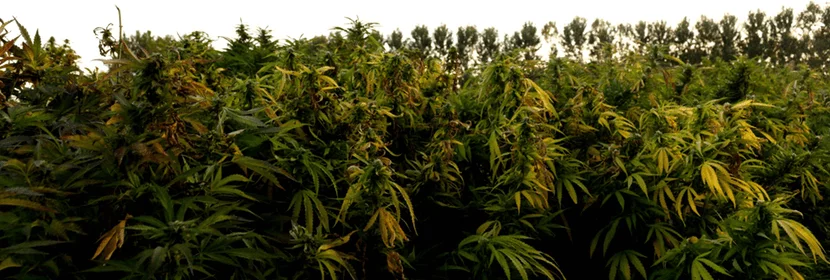It’s Spring, the time of year when nature starts to fill with the sights and sounds of wildflowers, birds, beasts and cannabis guerrilla grow activity! For some cannabis lovers, the guerrilla grow is an action of necessity, while for others it is the thrill of the challenge – but most guerrilla growers will agree that there ain’t nothing sweeter than tasting bud harvested from a ‘secret space’.
Unlike a home grow, there is a considerable amount of risk involved with sowing your cannabis seeds in a space that does not belong to you. Nevertheless, with the right management (and a bit of good luck) a cannabis guerrilla grow can be rewarding. Over the years, Paradise Seeds has met many guerrilla growers who have shared their experiences and, based on these, here are some of the main logistical issues that need to be considered.
Guerrilla Cannabis Grow – Location, location, location
While it may seem like there are guerrilla cannabis grow spaces everywhere, finding the right spot is actually much harder than you think. An experienced guerrilla grower has a good nose for a prime spot however and will always be keeping a look out for one. It has to be accessible, but at the same time be far enough away from people traffic and be near a good water source.
Experienced growers will plan their guerrilla grow with an eye on the seasons – anticipating how the surrounding area will change through Spring, Summer and Autumn. This means finding a spot that will not become too overgrown with vegetation – starving the cannabis plants of light in the early days – but also will not fall back when Autumn arrives, leaving the cannabis plant naked and exposed to view! For this reason berry bushes or ferns are a good source of cover.
In urban spaces, this requires anticipating how that space might be used as people begin to come outside in warmer weather (wasteland plots can be good, parks and other public spaces are a definite no!). Extra attention also needs to given to the smell, the most common give away of an urban hiding place, and avoiding proximity to public paths and neighbours down wind.
Urban guerrilla growers tend to give more focus to camouflage techniques, in order to make their plants blend into their environment. For this reason, using techniques such as topping, LST and super cropping produce a sculpted, more low-lying cannabis plant (check out our Skunkworks video series for expert tips from the Top Shelf Grower) that can be more easily concealed. Another popular method is to grow autoflowering strains which have reduced height and a more compact composition.
Establishing the Grow
Most guerrilla growers will plant their cannabis seeds at home and plant out when they have healthy seedlings. If sowing direct into soil it is important to clear ground, so that the seedling has a chance of competing with the plants around it, and preparing the soil with a mix that will promote good growth (ie nutrient based and mixed with perlite, coco or clay balls for good aeration).
Pots are easier for management (they can be moved around if needed), but they do require consistent watering. One useful tip is to use gravity fed autopots, which prevent the need for constant review. Another option favoured is the use smart pots with a half/half mix of soil and water absorbing crystals that will harvest and store rainfall. In more southern regions, where the summer heat and sun is intense, water is inevitably the crucial element to any guerrilla grow. Planting out in late June/early July will also avoid problems with pests.
Risk Management
The dedicated cannabis guerrilla grower is always thinking about potential risks. Managing these successfully is the difference between a good harvest and a bad disappointment. A key factor in risk management is location and doing whatever is needed to make it secure right the way through the plant’s life cycle – from cannabis seed to harvest – and that begins with finding a good pest resistant strain such as Spoetnik #1, Belladonna or Durga Mata.
Hard to get to places are preferable. One guerrilla grower uses a kayak to access plants grown by a riverside while another takes great pride in cutting a tunnel into a large patch of blackberry brambles where he has cut out a clearing (a trick learned from one of the original authorities on the art of the guerrilla grow, Jorge Cervantes).
As already mentioned, it is better to plant seedlings and these need to be protected from the attentions of animals such as rodents, rabbits and deer. While four legged animals are a nuisance, it is the two legged human species which is the biggest threat to the cannabis guerrilla grow.
The best guerrilla grows are set up with the necessary self-management in place to leave the plants on their own for long periods of time. One of the risks of doing frequent checks is that very quickly a path will form, so another guerrilla grower’s tip is to try and vary the approach route. Choosing a quiet time of day to pay ‘the girls’ a visit – early morning or dusk – is also advised.
This is a rule that is extended to harvest time, which is the final (and most heart palpitating) risk. The best guerrilla growers will make sure they have a good cover story in case of discovery at this crucial time . We have heard of people pretending to be looking for lost dogs, bird watching or an innocent hiker (complete with a compass and a map as corroborating props) who accidentally finds an illegal cannabis crop!
For every triumphant cannabis guerrilla grow harvest there is inevitably a handful of disappointing fails. However, most guerrilla gardeners agree that the outlaw set up is a seductive art to master…


